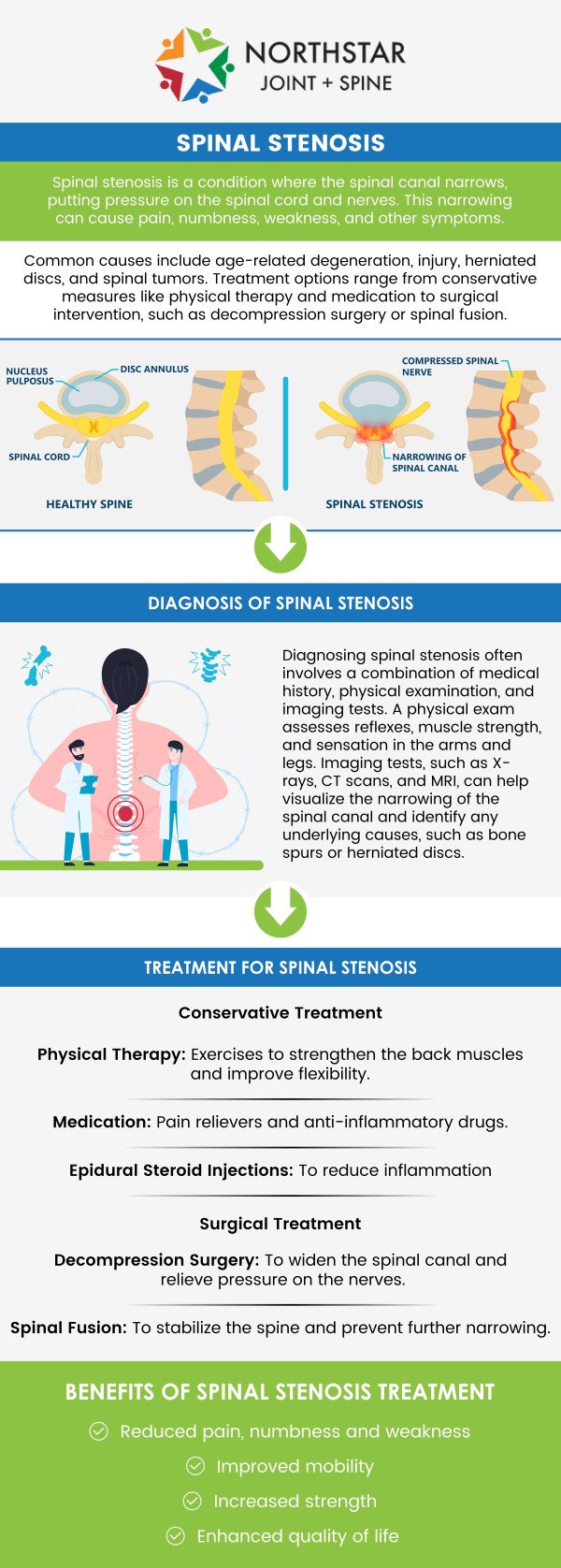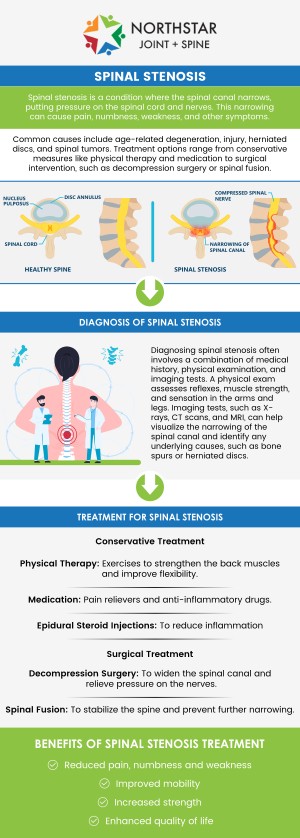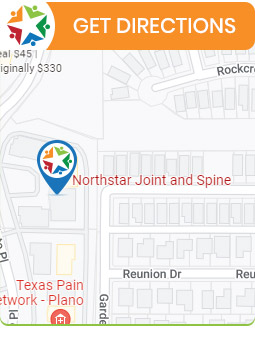Spinal Stenosis Specialist in Plano, TX
Spinal stenosis occurs when the spaces in the spine narrow, putting pressure on the nerves. This can cause symptoms like back pain, numbness, tingling, and difficulty walking. In severe cases, it may lead to muscle weakness or loss of bladder control. Board-certified Dr. Robert J. Nocerini, MD, at Northstar Joint and Spine offers treatment to relieve symptoms and improve mobility. For more information, contact us today or schedule an appointment. We are conveniently located at 7704 San Jacinto Pl Suite #200 Plano, TX 75024.


Table of Contents:
What is spinal stenosis?
What are the symptoms of spinal stenosis?
What are the causes of spinal stenosis?
How is spinal stenosis treated?
Why Choose Dr. Robert Nocerini at Northstar Joint and Spine as Your Spinal Stenosis Specialist in Plano, TX
Spinal stenosis is a condition that occurs when the spaces within the spine narrow and begin to exert pressure on the spinal cord or the surrounding nerves. This compression has the capacity to develop gradually over time. It most often affects the lower back or the neck. The narrowing may not cause immediately observable problems at first, but as it progresses, it can start to interfere with nerve function and lead to pain and other symptoms that impact daily movement and comfort.
The specialists at Northstar Joint and Spine assess spinal stenosis both from the perspective of the narrowing itself as well as how it changes the way a patient feels and moves. Treatment is often centered on relieving the pressure around the nerves while improving stability and flexibility. When treatment is implemented early on, some patients find that conservative methods such as physical therapy and medication management provide enough relief. In other cases, injections like epidural steroids or facet joint blocks are used to help control inflammation and nerve irritation without the need for surgery.
Symptoms of spinal stenosis can vary among patients, depending on which part of the spine is affected. Some individuals may notice persistent back or neck pain, while others may develop more specific issues like numbness, tingling, or a feeling of weakness in the arms or legs. Patients may also notice discomfort in the lower back that worsens when standing or walking for long periods, but feels better when sitting or leaning forward slightly.
Because symptoms can often slowly increase in severity, patients sometimes adapt their movements without realizing the underlying cause. At Northstar Joint and Spine, careful evaluation helps determine whether stenosis is the reason behind the discomfort. Providers collaborate with patients by reviewing their health history and discussing their symptom presentation, assessing nerve function, and using a variety of diagnostic tools to guide personalized care. Whether the symptoms are mild or more advanced, a treatment plan can be uniquely tailored to help individuals move through daily life with less pain and greater ease.
Spinal stenosis is associated with various causes, however, it often stems from natural aging processes that can lead to gradual changes in the spine. As people get older, the discs between the vertebrae can shrink and become drier, joints can also thicken, and bones have the potential to develop growths that intrude into the spinal canal. Genetics, repetitive stress on the spine, and overall wear over the years, among many other factors, can all influence the onset of stenosis and how early the signs begin to show.
To better understand what is causing a patient’s spinal stenosis symptoms, the team at Northstar Joint and Spine may recommend using a combination of imaging studies and diagnostic injections. Tools like facet medial branch blocks and other types of nerve blocks can help identify the specific areas contributing to pain. With a clear diagnosis, treatment plans can then be built around the patient’s unique needs.
How spinal stenosis is treated depends on patient presentation and other circumstances, however, it often starts with strategies aimed at reducing nerve compression and improving function. Conservative approaches such as targeted physical therapy and personalized medication management are often the first steps. When additional support is needed, advanced options like epidural steroid injections, sacroiliac joint injections, and facet injections can be introduced to relieve swelling and nerve irritation, creating more space within the spine and reducing painful symptoms.
The specialists at Northstar Joint and Spine work with individuals to tailor every plan based on how the patient’s symptoms present and how much the stenosis is interfering with daily life. In some situations, more specialized techniques like spinal cord stimulation or peripheral nerve stimulation can be offered when traditional treatments are not enough. Every option is discussed with patients encouraged to ask questions and participate in designing a plan that fits both their symptoms and long-term goals for mobility and quality of life.
As a Board-Certified specialist, Dr. Robert Nocerini, MD provides comprehensive evaluations for patients dealing with spinal stenosis—a condition where the spinal canal narrows and puts pressure on nearby nerves. He tailors each treatment plan to address the severity of the condition, offering options designed to alleviate stiffness, numbness, or lower back discomfort while improving flexibility and mobility.
Dr. Nocerini’s patient-first philosophy centers on helping individuals regain control over their movement and comfort. Through careful assessment and targeted therapies, he works to minimize nerve compression and optimize spine function. His extensive experience allows patients to feel confident knowing they’re receiving attentive, advanced care from one of Plano’s leading spine specialists.
Spinal stenosis treatment is available at Northstar Joint and Spine. For more information, contact us today or schedule an appointment. We are conveniently located at 7704 San Jacinto Pl Suite #200 Plano, TX 75024. We serve patients from Plano TX, Willow Bend TX, Frisco TX, Allen TX, Addison TX, North Dallas TX, and surrounding areas.

Check Out Our 5 Star Reviews


Additional Services You May Need
▸ Back Pain
▸ Chronic Pain
▸ Epidural Steroid Injections
▸ Spinal Cord Stimulation
▸ Viscosupplementation
▸ Genicular Nerve Blocks
▸ Facet Injections
▸ Joint Injections
▸ Sacroiliac Joint Injections
▸ Lumbar and Cervical
▸ Facet Medial Branch Blocks
▸ Diagnostic Nerve Blocks
▸ Medication Management
▸ Neck Pain Doctor
▸ Diabetic Peripheral Neuropathy
▸ Headaches
▸ Suboxone
▸ Botox for Migraines
▸ Peripheral Nerve Stimulation
▸ Spine
▸ Joints
▸ Muscles
▸ Bones

Additional Services You May Need
▸ Back Pain
▸ Chronic Pain
▸ Epidural Steroid Injections
▸ Spinal Cord Stimulation
▸ Viscosupplementation
▸ Genicular Nerve Blocks
▸ Facet Injections
▸ Joint Injections
▸ Sacroiliac Joint Injections
▸ Lumbar and Cervical
▸ Facet Medial Branch Blocks
▸ Diagnostic Nerve Blocks
▸ Medication Management
▸ Neck Pain Doctor
▸ Diabetic Peripheral Neuropathy
▸ Headaches
▸ Suboxone
▸ Botox for Migraines
▸ Peripheral Nerve Stimulation
▸ Spine
▸ Joints
▸ Muscles
▸ Bones






